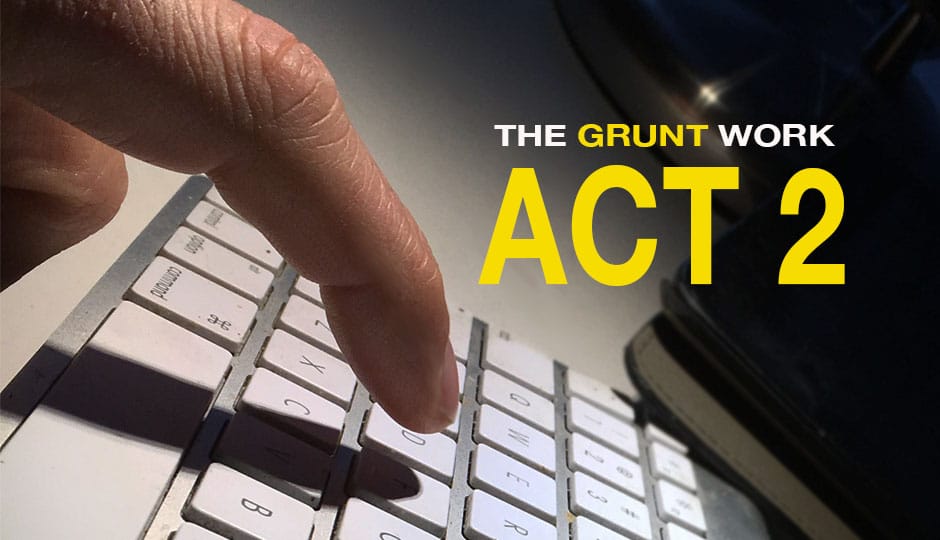Act Two is where structural problems commonly invade the script more than anywhere else, and tilt the entire story out of focus. To combat this tendency, it’s best to think of Act Two in two parts, the first half and the second half.
By Charles Deemer, Edited by Stavros C. Stavrides
Act Two, Part One
Act Two begins with the protagonist firmly in the “extraordinary” world, the new experience of the story, with no turning back. Initially, things go well. for example:
- The scientist in ‘Jurassic Park’ observes the roaming dinosaurs with awe.
- Benjamin in ‘The Graduate’ happily begins an affair with Mrs. Robinson.
- Will in ‘Shakespeare In Love’ overcomes writer’s block with a new play in rehearsal and a mysterious new actor before him.
Midway through Act Two, ‘part one’ of the act moves into part two – a major plot point called the MIDPOINT.
As with all plot points, this spins the story in a new direction but sometimes it also defines a new goal for the protagonist. Examples:
- In ‘Jurassic Park’, the prehistoric animals get free during a storm, terrorizing everyone; the dangerous aspect of the theme park is introduced.
- In ‘The Graduate’, Benjamin decides he’s in love not with Mrs. Robinson but with her daughter, Elaine; He has a new goal.
- In ‘Shakespeare In Love’, Will discovers that the mysterious actor is really a woman, Viola, the love of his life, his muse – and he now is writing from the energy of her love.
In each case, the story spins into a broader, more complex dimension. More is going on. This greater density foreshadows the trouble that lies ahead.
NOTE: Lew Hunter, the author of Screenwriting 434, has called writing Act Two the “blue collar” work of screenwriting. He is absolutely correct. Act Two with its two parts makes it as long as Acts One and Three combined. It’s why some teachers refer to a four-act paradigm rather than a three-act paradigm: four equal parts. We prefer retaining the three-act terminology because it meshes so well with the beginning-middle-end structure, which is the essence of dramatic storytelling.
Act Two, Part Two
In the last half of Act Two, the journey of the protagonist turns downward, ending at the end-of-act plot point, which is the low point of the hero’s journey. It is here that all seems lost:
- In ‘Jurassic Park’, the security system of the park collapses when the computer system has to be rebooted. This hugely magnifies the danger from the animals.
- In ‘The Graduate’, Benjamin learns that Elaine has been pulled from school and is being rushed into marriage.
- ‘In Shakespeare In Love’, Viola’s disguise is made public and the theater is shut down.
In each case, things look grim for the protagonist: the scientist’s life is in danger, along with everyone else’s; Benjamin looks to lose Elaine, and Will looks to lose both his wonderful new play and Viola.
It is the purpose of Act Three, which we cover in The Challenge of Act Three, to resolve these issues back in favor of the protagonist.
This post is a support article for the chapter “Screenwriting” in
Cyber Film School’s Multi-Touch Filmmaking Textbook.
Typical Problems with Act Two
Here are some typical problems that can occur in Act Two:
- Loss of Focus
- Insufficient Build
- Antagonist’s Revenge
- Too Hi a Low Point
Loss of Focus
The hero’s journey that was clearly set up in Act One becomes lost as the story becomes more complex.
Sometimes subplots become more important than the central dramatic issue; sometimes minor characters become more interesting than the protagonist. The spine of the story collapses.
Insufficient Build
In the journey through Act Two, tension must build right along with the complexity of the story.
This means there must be a through-line connecting the turns of the story and that the stakes must be raised at each twist. The story is like a poker pot with the bets raising and raising again.
Antagonist’s Revenge
If one character is apt to steal the focus from the protagonist, it is the bad guy, the antagonist.
Often bad guys are more interesting to write about than good guys, but you must remember that your story always belongs to the hero.
Study “Silence of the Lambs” for how a dynamic antagonist can be created without sacrificing focus on the protagonist.
Too high a low point.
Movies are bigger than life in all ways. Often writers do not put their protagonists in deep enough a hole at the end of Act Two. The stakes aren’t high enough, the danger is not great enough, and the sense of defeat not threatening enough.
A common command to screenwriters during the rewriting process is “crank it up!” Make the story matter more to the hero — and to the audience. Make the story bigger than life.
Make Cinema Your Language
Cinema is a language we all understand, but not everyone ‘speaks’ it–directors do.
This interactive, self-guided textbook is a director’s toolbox, made for Apple Books.
Embrace a solid foundation with a future-proof, classic combo of theory, technique, history, and critical thinking.
Gain practical, adaptable creative skills and insight that transcend technological changes, be it a camera, mobile device, or AI.

Modelled upon the essentials of first-year film school programs.

